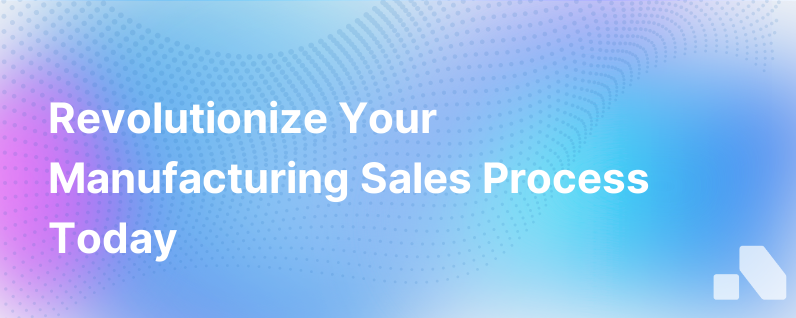
In an age where technology continues to reshape consumer behavior and expectations, manufacturers find themselves at a crossroads. Traditional sales tactics that once drove the industrial engine of our world are now giving way under the pressures of digitalization. Manufacturers who wish to thrive must adapt by modernizing their sales processes.
Modernizing a sales process doesn’t mean throwing out everything and starting over; it's about enhancing and streamlining the existing process with contemporary tools and tactics. Let's explore step by step how to modernize a manufacturer's sales process effectively.
Understanding The Modern Buyer
The first step in this journey is to develop a deep understanding of the modern buyer. Today's buyers are well-informed and often make up their minds before even engaging a sales representative. They expect personalized experiences, instant responses, and solutions that cater specifically to their unique needs.
Manufacturers must adapt by adopting a customer-centric sales approach that prioritizes the needs and preferences of the buyer, providing educational content and leveraging data to understand and anticipate the buyer’s needs.
Integrating Digital Tools in Sales Operations
The backbone of a modern sales process is digital integration. Manufacturers must embrace technologies that automate and facilitate sales tasks to improve efficiency.
- Customer Relationship Management (CRM) Systems: Implementing a robust CRM system allows sales teams to keep a record of every customer interaction, enabling them to provide personalized engagement.
- Sales Enablement Platforms: These offer a repository for sales collateral, streamlining the sharing of information and resources between sales and marketing teams.
- Configurators and Product Customization Tools: Particularly important for manufacturers, these tools empower buyers to visualize and customize products before the purchase.
Embracing Mobile Technologies
With the workforce becoming increasingly mobile, having a sales process that can go anywhere is crucial. Mobile sales apps offer sales teams the flexibility to conduct business anytime, anywhere, enabling quicker responses to customer queries and the ability to close deals outside the confines of an office.
Leveraging Data Analytics and AI
In the era of big data, sales strategies should be measured and driven by concrete analytics. This involves:
- Performance Tracking: Using key performance indicators (KPIs) to monitor sales efficiency, such as conversion rates, cycle times, and customer acquisition costs.
- Predictive Analytics: Utilizing artificial intelligence (AI) to analyze buying patterns, predict future market trends, and inform strategic decision-making.
- AI for Personalization: Implementing AI-driven tools to create highly targeted and personalized outreach campaigns.
Modernizing sales means adopting an agile mindset that is open to constant learning and optimization based on performance data.
Enhancing Sales Training and Development
As the sales landscape evolves, so too must the skills and knowledge of the sales team. Manufacturers need to invest in regular training and development to ensure that their sales force is adept at using new technologies and contemporary sales strategies. This includes digital communication training, insights into the latest market trends, and the art of consultative selling.
Implementing an Omnichannel Sales Approach
An omnichannel approach integrates various sales channels – online, offline, direct, and indirect – to provide a seamless customer experience. For manufacturers, this could mean combining traditional in-person sales tactics with e-commerce platforms, social selling, or remote sales via video calls.
Fostering Collaboration Between Sales and Marketing
A modernized sales process bridges the gap between sales and marketing. Close collaboration ensures that marketing campaigns are aligned with sales goals, messaging is consistent across all touchpoints, and leads are efficiently nurtured through the sales funnel.
Moving Toward Subscription Models and Value-Based Selling
Where applicable, manufacturers should consider diversifying revenue streams with subscription-based models or value-added services. This shift requires a sales process that goes beyond a one-time transaction to build long-term customer relationships.
Also, value-based selling – focusing on the value your product brings to the customer, rather than its features or costs – aligns with the modern buyer’s desire for solutions that directly address their challenges.
Optimizing the Customer Journey
Examine each touchpoint of the customer journey to eliminate friction and enhance the overall experience. This might involve redesigning the website for improved user experience (UX), implementing chatbots for 24/7 customer service, or utilizing Virtual Reality (VR) for virtual product demonstrations.
Reassessing Sales Compensation and Incentives
Compensation and incentive structures must reflect the goals of a modernized sales process. These should promote not just the closing of sales but also activities that nurture leads, build long-term customer relationships, and encourage the adoption of new sales technologies.
Continuously Monitoring and Refining
Finally, it's crucial to continuously monitor the effectiveness of your modernized sales process and refine it. This means seeking feedback from customers, analyzing sales data, and staying abreast of industry trends to make iterative improvements.
Conclusion
Modernizing a manufacturer’s sales process is not a destination; it's an ongoing journey. As tools evolve and buyer behaviors change, so too must the sales strategies. By embracing digital tools, personalizing the sales experience, and continually iterating the sales process, manufacturers can position themselves competitively in an ever-evolving marketplace. Remember, it's not just about selling a product; it's about delivering solutions in the way today's buyers expect to receive them.